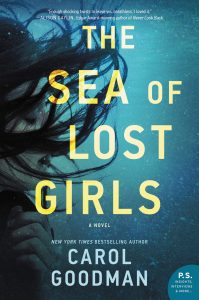 Carol Goodman’s luscious prose doesn’t mask her storytelling drive, and it’s a haunting and unforgettable combination. The Sea of Lost Girls is set at a girl’s boarding school in Maine, centering on the family of Tess, Harmon and Rudy. Tess and Harmon both work at the school; Rudy is Tess’s son and Harmon’s stepson, as well as a student at the school. The book kicks off with him texting his mother in the middle of the night, and she rushes off to find out what’s wrong.
Carol Goodman’s luscious prose doesn’t mask her storytelling drive, and it’s a haunting and unforgettable combination. The Sea of Lost Girls is set at a girl’s boarding school in Maine, centering on the family of Tess, Harmon and Rudy. Tess and Harmon both work at the school; Rudy is Tess’s son and Harmon’s stepson, as well as a student at the school. The book kicks off with him texting his mother in the middle of the night, and she rushes off to find out what’s wrong.
As a reader, I was instantly drawn into the dynamic between Tess and her son, who has had some troubles but whom she loves fiercely. Her greatest goal is that of any mother’s: to protect him. And, as it turns out, he needs it. His girlfriend, Lila, whom he had been fighting with, turns up dead the next morning and suspicion falls on both Rudy and Harmon in turn.
Tess is forced to re-examine her life and the events leading up to Lila’s death as her husband and son are both taken to the police station as persons of interest. So much of Tess’s story is about shame – as her backstory is teased out, we learn of her very early relationship with an older man who virtually kept her prisoner. She has obviously started over, but the scars remain.
As Tess continues her own investigation, it becomes clear that Lila was working on a project about several girls who had disappeared from the school in the 50’s – myth has declared them victims of the “maiden stone,” but there’s more to the story, which comes out in various ways and at various times throughout the book.
The shame Tess feels is played back to her in many ways, and the ultimate reflection of it is a school performance of The Crucible, where Arthur Miller’s story of hysterical young women shamed, accused and sent to their deaths backs up her own themes.
Goodman has created a story reflective of our own times and the changes and lack of changes that still exist. The idea of demeaning and shaming women, unfortunately, is still with us, but the way young women are starting to fight back and respond is illuminated in Goodman’s story. Mystery novels are so often intelligent examinations of life as it is lived at the moment, and this book is an illustration of the ways an author can tell a story and write about the times she’s living in simultaneously.
The mystery element is fabulous, and the ending has a wonderful twist, the kind that’s a surprise but has been carefully set up by this intelligent author. There was much to think about when I finished, and much to enjoy as I sped through the pages of this wonderfully written and fully realized novel.